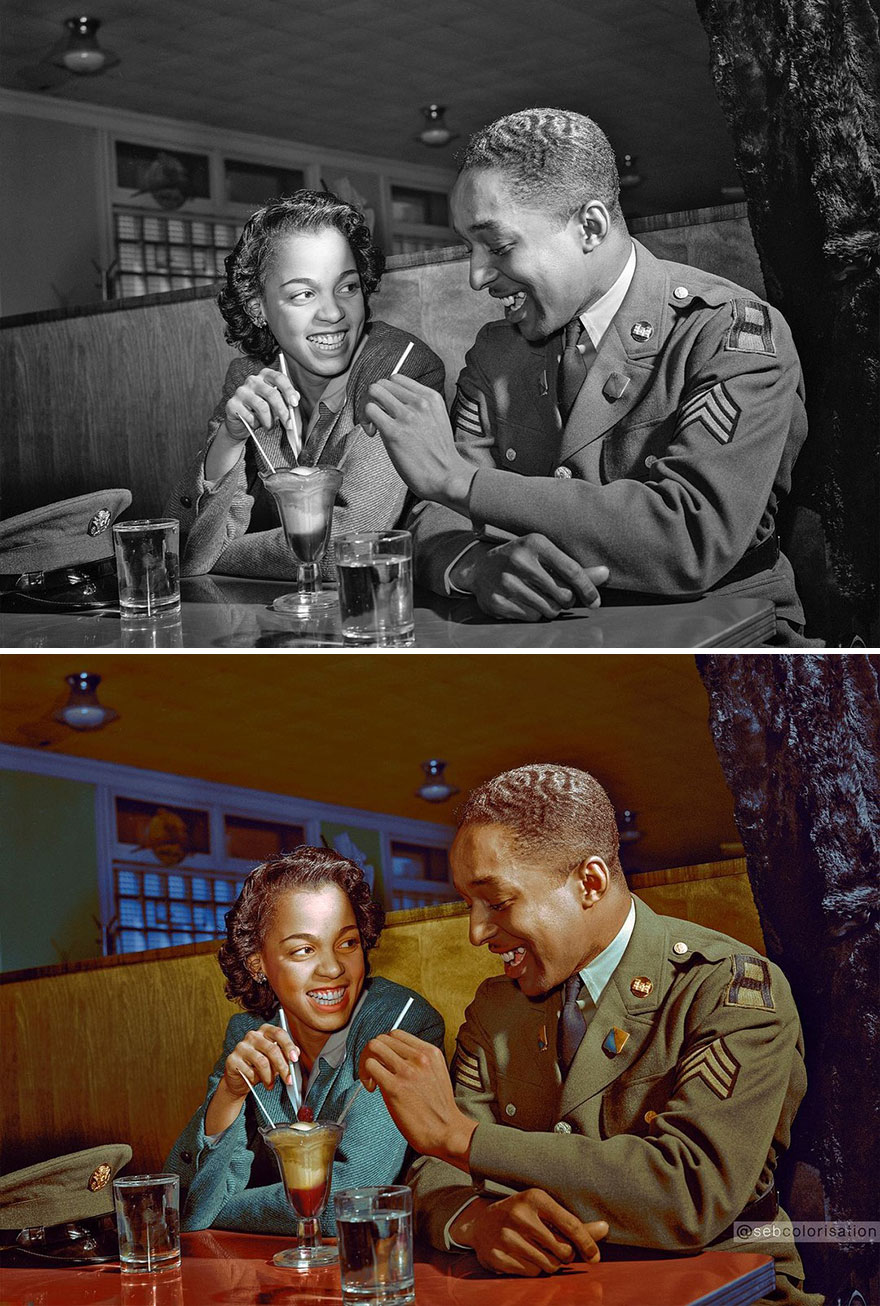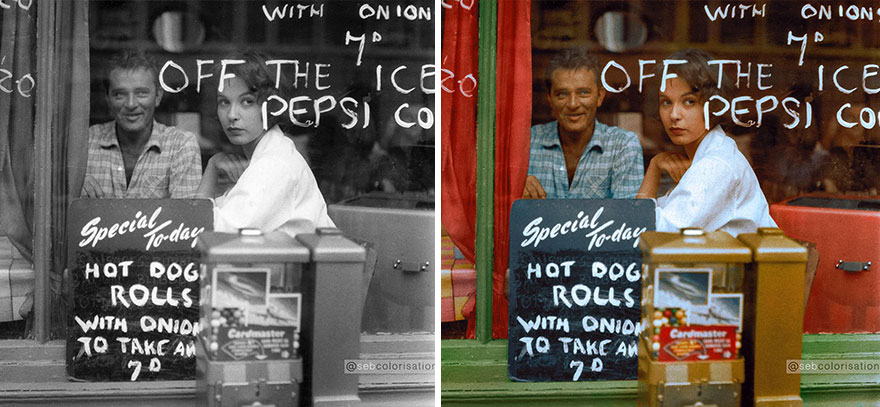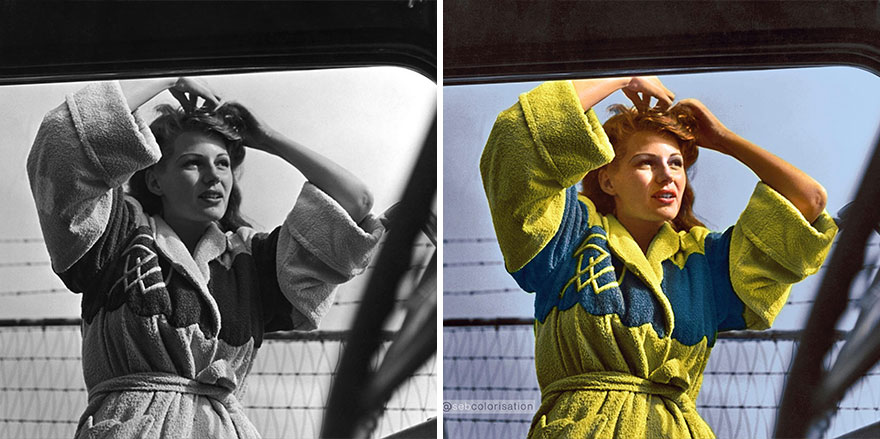
30 Old Colorized Photos That Might Change The Way You Perceive History By Sebastien De Oliveira (New Pics)
Interview With ArtistIt’s hard to imagine being limited to taking exclusively black and white photos. At the same time, B&W photography remains popular, and images without a full range of colors have their own unique character.
However, nothing is impossible nowadays, and even something like adding color to old photographs, if done properly, can completely change the look of the picture and our perception of what we’re looking at. The French artist Sebastien de Oliveira specializes in digitally colorizing vintage photos. We’ve already featured some of his earlier works as an illustrator and photographer, so check out our previous Bored Panda posts. Today, we've compiled the most recent selection of images Sebastien added some color to, so you can admire the before and after effects of his work.
More info: Instagram
This post may include affiliate links.
Sergeant Franklin Williams, Home On Leave From Army Duty, With His Girlfriend Ellen Hardin, Splitting An Ice Cream, Baltimore, Maryland, March 1942
Photo by Arthur Rothstein
We reached out to Sebastien de Oliveira to ask him some questions about the old photographs and the fresh touch of color he adds to them. First, we were interested in the artist’s approach to AI and its ability to modify photographs in seconds. Sebastien told us: “For me, AI is still not satisfying for colorizing old photos. I don’t use it. I colorize like a painter, by hand, so I don’t need a machine to do it for me. It is a mistake to avoid thinking of colorization as a piece of art and not only a technical process. Give an image to ten different colorists, and they will give you ten different versions. I understand that it can be seen as a threat, but I think there will always be room for different techniques. The arrival of photography in the history of art didn’t make painting disappear; it made it evolve.”
Sebastien added: “I see my work as an adaptation of an original, so my choices are completely personal, a result of my references. My version and an AI version will always be two different things.”
Actress Sophia Loren, Rome, 1963
Photo by Peter Basch
Activities At Camp Nathan Hale, Southfields, New York, August 1943
Photo by Gordon Parks
Asked which photographs he likes editing the most, the artist answered: “I love old photos from the 1930s to the 1950s, with a soft spot for the 1940s. The designs, the clothes, the overall atmosphere—all evoke a strong sense of nostalgia for me. The best way I've found to travel back in time is through colorization. I'm particularly drawn to simple street views and urban photographs, capturing people walking around, busy streets filled with cars—these are simple yet powerful images from the past that I adore.”
John Fitzgerald Kennedy And Jackie Kennedy In 1953
Marilyn Monroe Reading, Beverly Carlton Hotel Los Angeles, 1952
Photo by André De Dienes
We were wondering how long it usually takes for Sebastien to finalize one image. We learned that: “It can take me anywhere from two to ten hours, depending on the complexity of the image. I need to select every single object by hand for my process, so it can be time-consuming. On average, it will take two to three hours, which isn't too much. My work as a photo retoucher in the fashion industry has trained me to be fast.”
Teenage Girls And Boys Train For Defense Work Made Possible By TVA At A National Administration School. Knoxville, Tennessee, June 1942
Photo by Arthur Rothstein
James Dean And Elizabeth Taylor Taking A Break From Filming "Giant" In June 1955
Photo by Richard Crump Miller
The images colorized by Sebastien look very realistic, and very often it’s very hard to say they weren't taken in color in the first place. We were curious what techniques the artist uses in order to create this seamless effect. We found out that: “My technique is not simple to explain in a few words. Let’s say that I observe a lot how the light works on objects—the reflections, the transparency, the temperature of the light—and all the different interactions between them, and I've found a technical way to reproduce them. The system involves colorizing not only each different object but also the different grays that compose each object. I also draw lessons from the impressionists and other painters who worked on the reproduction of light. Additionally, I take a lot of inspiration from old color photos from the past, such as the Autochromes of the Lumière brothers.”
Street View, July 1958
Photo by Robert F. Kniesche
Pedestrians On Broadway Look Through A Restaurant Window To Watch A Cook Prepare A Pot Of Spaghetti. New York, 1937
Asked if photo retouching is his full-time profession, Sebastien de Oliveira said: “I don’t make a living from it, but it is already a good part of my activities. I collaborated on some projects, such as the book 'Extraordinary Voyages' for Louis Vuitton, for example, or an article for France-Amérique magazine, and I also took some orders. I would love to work on more projects that involve colorization.”
Teenagers Walking In The Fallen Leaves, 1940s
Is it me or those teenagers looks definitely like people in their 30s? It's not the first time i have this feeling watching old pics where people looked older that today's people.
People In Vale, Oregon, For The Fourth Of July Celebration
Photo by Russell Lee, in 1941
Lastly, we asked the artist to tell us something about his book that was released last year: “A publisher liked my work and proposed to publish a book. We worked for six months on it, and it was released in October 2022. 'Back to America' contains 174 colorizations from 1935 to 1943. It is a large selection of images from the Farm Security Administration, available at the American Library of Congress. I am really proud of it, and it has been well-received in France. It offers a genuine time travel experience in the U.S. during the '40s and serves as a tribute to American cinema. They have asked me for a second book, so I am working on this new project right now. It is scheduled for release in May 2024.”
Waiting Room At Greyhound Bus Depot, Detroit, Michigan, Photographed By John Vachon In August 1942
Having A Drink In A Bar In Front Of The Moulin Rouge, Paris, Photographed In 1960
How fun it would have been to go to Moulin Rouge! Definitely looks like a ad!
Marcello Mastroianni, Milan, 1960
Claire Bloom And Richard Burton, Stars Of The Film "Look Back In Anger", Taking A Break From The Filming To Grab A Bite To Eat In A Cafe In London, 20th September 1958
Italian Americans On The Lower Side Of Manhattan. Ice Vendor On Mulberry Street, January 1943
Photo by Marjory Collins
Iconic Carhop Girl, Circa 1945
Photographed By Russell Lee In May 1940
High School Students Crossing The Street, Phoenix, Arizona, May 1940
Photo by Russell Lee
Here's another angle of the same group of kids crossing the street: https://www.shorpy.com/node/23640
Actress Doris Houck, Photographed In Los Angeles In 1945
Betty Grable Photographed In 1943
Mary Cumming, 21, Secretary In The Office Of Designer Raymond Loewy, New York, 1956
my gosh, I hope she didn’t have to copy the whole book in this position and with a magnifying glass !?! patience and fortitude, I bet you did !
Actress Monica Vitti Reading Magazines At The Airport In Rome, July 1961
Street Scene, Provincetown, Massachusetts, Summer 1937
Photo by Edwin Rosskam
Rita Hayworth 1941
Photo by Bob Landry
Young Pin Up Marilyn Monroe Posing For Earl Moran, 1947
Center Market Place, New York, 1940
Photo by Andreas Feininger
Chauffeurs And Limousines For The Garden Party At The New Zealand Legation, Washington, D.C., May 1942
Photo by Marjory Collins
"Virginia Lively Used To Be A Beauty Operator. Today She Works At A Filling Station." Louisville, Kentucky, June 1943
Photo by Howard Hollem
Sergeant George Camplair On One Of His Many Visits To The Post Exchange, Fort Belvoir, Virginia, September 1942
Photo by Jack Delano
Waiting For A Stoplight In Washington, D.C., Spring 1939
Photo by David Moffat Myers
Soldier With His Girlfriend, Arlington, Virginia, June 1943
Photo by Esther Bubley
U.S. Navy Intelligence Bureau. Fingerprint Department. Washington D.C., 1918
A Room At Idaho Hall, Arlington Farms, War Duration Residence Halls. Arlington County, June 1943
Photo by Esther Bubley
Pennsylvania Turnpike. Trucker Paying Toll, July 1942
Photo by Arthur Rothstein
Restaurant Counter, San Francisco, 1941
114 Rue De Sèvres, Paris Photographed In 1950
Boys And Girl On Bicycles, Detroit, Michigan, July 1942
Photo by Arthur Siegel
Street In Aliquippa, Pennsylvania, January 1941
Photo by Jack Delano
Unnamed
the sign on the truck says "City of Mt Clemens" or maybe it's "Mt Clemins" or "Mt Clements". The only town close to those I could find is Mt Clemens in Michigan, but the lack of snow in the picture close to Christmas kinda argues against it being in MI.
Small Lunchroom Where Students Gather Near Phoenix Union High School. Phoenix, Arizona, May 1940
Photo by Russell Lee
FSA Borrower And His Seven Children, Laredo, Montana, August 1941
Photo by Marion Post Wolcott
California, 1945
New York. Looking North On Broadway At Times Square, September 1942
Photo by Marjory Collins
September 1942. "Fort Belvoir, Virginia. Sergeant George Camplair Cleans His Rifle Regularly"
Photo by Jack Delano
The title suggests that the colorized photos will, “Change The Way You Perceive History.” Uh, nope. Just because there’s color included doesn’t make the picture more or less interesting.
Yes and many historians and archivists hate when people, other than the photographer colorize photos because you change it and it's not a true representation like the photograph
Load More Replies...I can;t help but feel that some of these are much more evocative in their original monochrome form. Black & White photography remains an art form in itself to this day.
The colors were so saturated that many of these looked more like postcards.
Yeah, I thought a number of them were too saturated and the first one needed the red hue removed. But I suspect that if you're a photog, you're likely to be extra critical. Many are really well done and you can tell a lot of work went into all of them.
Load More Replies...The title suggests that the colorized photos will, “Change The Way You Perceive History.” Uh, nope. Just because there’s color included doesn’t make the picture more or less interesting.
Yes and many historians and archivists hate when people, other than the photographer colorize photos because you change it and it's not a true representation like the photograph
Load More Replies...I can;t help but feel that some of these are much more evocative in their original monochrome form. Black & White photography remains an art form in itself to this day.
The colors were so saturated that many of these looked more like postcards.
Yeah, I thought a number of them were too saturated and the first one needed the red hue removed. But I suspect that if you're a photog, you're likely to be extra critical. Many are really well done and you can tell a lot of work went into all of them.
Load More Replies...
 Dark Mode
Dark Mode 

 No fees, cancel anytime
No fees, cancel anytime 























































































































